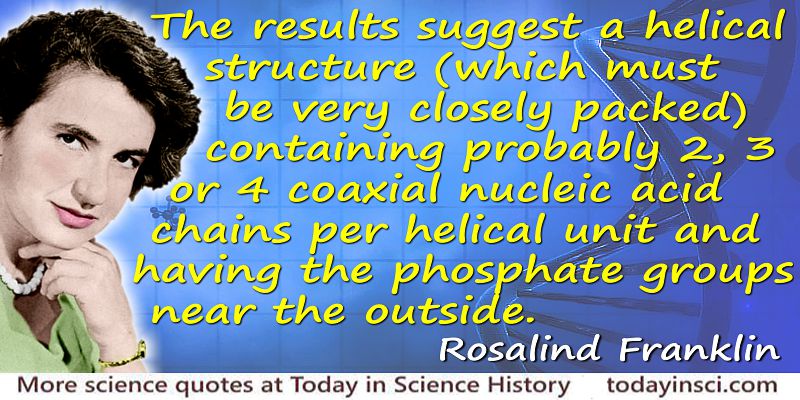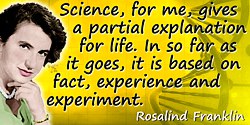Today in Science History - Quickie Quiz
 (source)
(source)
|
Rosalind Franklin
(25 Jul 1920 - 16 Apr 1958)
English physical chemist and X-ray crystallographer whose X-ray photographs gave Crick and Watson the clue needed to interpret the helical structure of DNA.
|
Rosalind Franklin
“The results suggest a helical structure”
Illustrated Quote - Large (800 x 400 px)
“The results suggest a helical structure (which must be very closely packed) containing probably 2, 3 or 4 coaxial nucleic acid chains per helical unit and having the phosphate groups near the outside.”
— Rosalind Franklin
Report (Feb 1952).
This quote comes from Rosalind Franklin’s part of the King’s College, London, Biophysics Unit report to the Medical Research Council in 1952.
Franklin had been working with X-ray crystallography since 1947 at the Central State Chemistry Laboratories in Paris, and had been recruited in 1951 to the Medical Research Council Biophysics Research Unit at King’s College, London, for a study of the DNA molecule structure that was in progress there. She joined the work with graduate student Raymond Gosling making and improving X-ray diffraction images of DNA. By May 1952, she had a good long-exposure photograph showing a distinct X shape filling the image which indicated the double helix backbone. In her section of the 1952 King’s MRC report, Franklin gave quantitative measurements for the interphosphate distances and discussed the external placement of the phosphates.
Text by Webmaster, with quote from report to the Medical Research Council, submitted in Feb 1952, as given in Anne Sayre,
Rosalind Franklin and DNA (2000), 126.
(source)See also:
- Science Quotes by Rosalind Franklin.
- 25 Jul - short biography, births, deaths and events on date of Franklin's birth.
-
Rosalind Franklin - context of quote “The results suggest a helical structure” - Medium image (500 x 250 px)
- Rosalind Franklin: The Dark Lady of DNA, by Brenda Maddox. - book suggestion.
- Booklist for Rosalind Franklin.
Nature bears long with those who wrong her. She is patient under abuse. But when abuse has gone too far, when the time of reckoning finally comes, she is equally slow to be appeased and to turn away her wrath. (1882) --
Nathaniel Egleston, who was writing then about deforestation, but speaks equally well about the danger of climate change today.
 Carl Sagan
Carl Sagan: In science it often happens that scientists say, 'You know that's a really good argument; my position is mistaken,' and then they would actually change their minds and you never hear that old view from them again. They really do it. It doesn't happen as often as it should, because scientists are human and change is sometimes painful. But it happens every day. I cannot recall the last time something like that happened in politics or religion. (1987) ...
(more by Sagan) Albert Einstein: I used to wonder how it comes about that the electron is negative. Negative-positive—these are perfectly symmetric in physics. There is no reason whatever to prefer one to the other. Then why is the electron negative? I thought about this for a long time and at last all I could think was “It won the fight!” ...
(more by Einstein) Richard Feynman: It is the facts that matter, not the proofs. Physics can progress without the proofs, but we can't go on without the facts ... if the facts are right, then the proofs are a matter of playing around with the algebra correctly. ...
(more by Feynman)
 (source)
(source)









